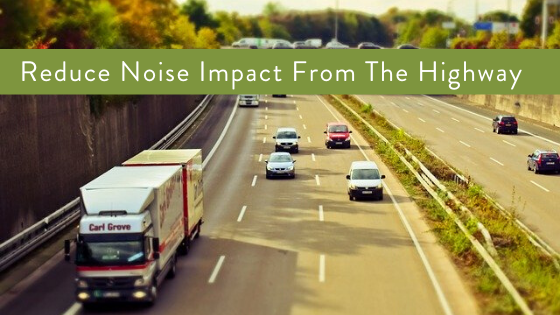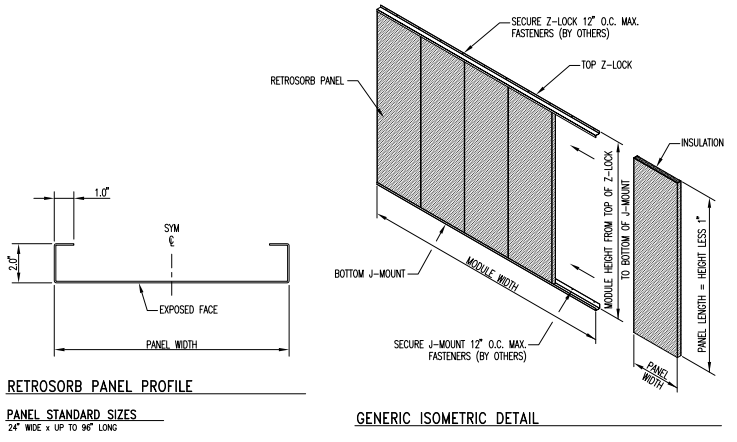Everyone used to think that getting rid of the sounds of heavy traffic and big vehicles was as simple as throwing up a concrete sound wall.
We talk about how to reduce the environmental and physical impacts of high sound levels below.
In theory, the highway noise barrier would stop sound waves from entering the community behind the walls.
The real truth is these highway walls amplified the noise and sent it bouncing over the barriers and blasting into nearby neighborhoods.
A more efficient highway sound barrier is using absorptive materials that prove to eliminate the sound waves instead of increasing and bouncing them off the walls.

Highway Noise Barrier Walls Strategy
Architects, developers, construction, and engineering teams use a variety of techniques to minimize the sound from Interstates and busy roadways.
The material, aesthetics, placement, and arrangement make a huge difference in trapping sound and killing it.
Engineers must oversee individual plans and how each part plays into the master design.
Site Planning For Highway Noise Reduction
One of the most common applications of site planning is to increase the amount of space between the sound maker and the receiver.
However, in a residential situation, it is not always easy to achieve this goal without buying up land near the highway and demolishing the buildings.
Using the buildings as storage or building new ones with a different orientation can help decrease noise levels.
Noise Absorbing Material
The noise absorbing material that goes on the buildings or walls makes a difference to how high frequencies are and the loudness of the sound. Now imagine that material being used for highway walls located next to residential neighborhoods.
Architects and designers use textures, trim, and windows to break up the sound wave as it hits the building. Interior designers can add solid walls and various elements to help reduce noise even further.

Highway Noise Barrier Design
The placement of windows, fire escapes, doors, easements, gutters, vents, and many attachments affect the way sound goes around a building. Reducing noise issues with a proper construction noise barrier will help provide an aesthetic design that works for your next project.
Using these structures to break down the sound wave helps with any noises the freeway noise barrier does not. For example, sound at levels higher than the wall.
The Right Type of Noise Barriers
The right type of noise barrier wall makes a difference in how much sound is absorbed back into the community. Concrete is a popular choice because it is affordable and quick to place.
Some landowners use soil like berms and recessed walls to block noise naturally. By using specific vegetation, the amount of sound captured is higher.
Acoustic panels are a newer wall design. Our company has over four decades of experience and nearly 15 years working with acoustic panels.
Our noise absorbing system has a noise reduction coefficient of 1.05. The federal standard says 1.0 is complete absorption.
Our outdoor sound absorbing panels go beyond the minimum rating to provide exceptional noise control to mitigate Interstate traffic sounds and the noise from semis and large equipment traveling the highways.
Why our Noise Barriers Work Better Than Concrete
Because our sound barrier panels kill the sound wave, there is no noise to reflect back into residential or commercial areas.
With textured panels, strategic openings, and scientifically proven sound-dampening materials, we help federal and local governments get rid of highway sound with a pleasant-looking product and many additional benefits.
Our noise barrier panels reduce the stressful impacts of loud noises on the environment providing a safer place for wildlife as well as residents and workers.
Benefits of Highway Noise Barriers
- Reduces stress-inducing noise
- No reflected sound waves and captures high and low-frequency waves
- Does not reflect like concrete
- Minimizes the physical, mental, and emotional impact of noise on the environment and community
- A variety of design patterns and wall colors for aesthetics
- Protects travelers from reverberations crossing between the barriers allowing for use along both sides of the highway
- No rotting, rusting, or animal nesting to worry about
- Major storm durability construction of the panels
- Lightweight use of these materials allows for walls in weight-limited applications
- Can be installed with as little as 3 team members
- Mobile and configurable allowing teams to take them down and reconfigure them for other areas to use
Ease of Installation
Many installers and construction teams like the way the sound barrier wall panels and frames go together in the absorptive system. The wall pieces slide into a locked frame and add stability to the structure. When complete, the barrier is nice to look at from the highway or the residential side of the wall.

Reducing highway noise takes many different parts that work together. The freeway noise wall is an important part of the equation. When you reduce the noise at the source by eliminating it, it keeps the sound levels from harming anyone, including the people on the highway.
To learn more about our wall solutions, please check out our highway sound barriers. We also have a variety of photos and videos that showcase how our walls work.
You can see what makes them so much better at eliminating highway noise.
Sources:
https://www.soundfighter.com/landscaping-for-privacy-and-noise-reduction/
https://www.soundfighter.com/what-is-an-acoustic-consultant/
https://noisebarrierwalls.com/noise-barrier-walls-vs-concrete-blocks/
https://noisebarrierwalls.com/minimizing-noise-pollution-commercial-construction-projects/
Thanks for sharing. I read many of your blog posts, cool, your blog is very good.
Can you be more specific about the content of your article? After reading it, I still have some doubts. Hope you can help me.
Thank you for your sharing. I am worried that I lack creative ideas. It is your article that makes me full of hope. Thank you. But, I have a question, can you help me?
Your article helped me a lot, is there any more related content? Thanks!
I don’t think the title of your article matches the content lol. Just kidding, mainly because I had some doubts after reading the article. https://www.binance.com/es-MX/register?ref=JHQQKNKN
Can you be more specific about the content of your article? After reading it, I still have some doubts. Hope you can help me. https://www.binance.info/sv/join?ref=PORL8W0Z
Can you be more specific about the content of your article? After reading it, I still have some doubts. Hope you can help me. https://accounts.binance.com/id/register-person?ref=GJY4VW8W
Can you be more specific about the content of your article? After reading it, I still have some doubts. Hope you can help me. https://accounts.binance.com/vi/register-person?ref=WTOZ531Y